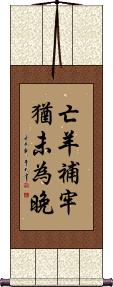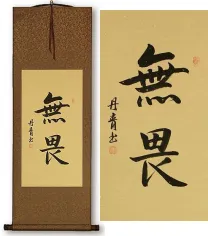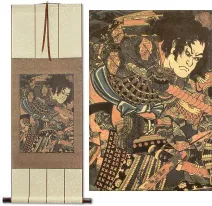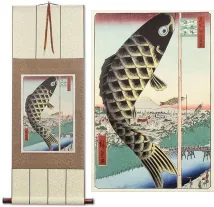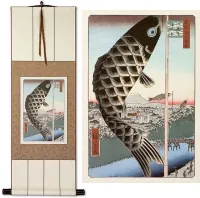Many custom options...
And formats...

Not what you want?
Try other similar-meaning words, fewer words, or just one word.
No Future in Chinese / Japanese...
Buy a No Future calligraphy wall scroll here!
Personalize your custom “No Future” project by clicking the button next to your favorite “No Future” title below...
Reiki - Master Symbol
大光明 is the master symbol “Daikomyo” or “Dai Ko Myo,” which is usually associated with the healing practice of Reiki.
This title can be translated as “Great Bright Light.” This symbol, as used in Reiki, alludes to “Enlightened Nature” or the radiance of a purified soul or deity.
Pronunciations in Chinese and Korean are included above but this title has no meaning except when used by a Reiki practitioner. In fact, this title is not that well known by those outside the Reiki community in Japan.
In Chinese, this would be interpreted as “Great Bright Future” (the second two characters alone create a word that means “bright future” in Chinese).
The Buddha is in Each Sentient Being
佛は衆生の中に在り is “Butsu wa shujo no naka ni ari” and means that the Buddha (potential for Buddhahood) exists in all beings in the universe.
So yes, your dog has the potential to be a Buddha (but only in a future reincarnation as a human). But all things, from the tiny cricket to the humpback whale have Buddha nature within them. If one takes the time to look and contemplate, one will see the Buddha in all things.
In Japan, sometimes the Buddha character is written 仏 instead of 佛, so you might see the whole phrase written as 仏は衆生の中に在り.
Note: Because this selection contains some special Japanese Hiragana characters, it should be written by a Japanese calligrapher.
Drain the pond to get all the fish
Kill the goose that lays the golden eggs
In 632 BC, Duke Wen of the Kingdom of Jin was about to lead an army against the forces of the Kingdom of Chu.
The Duke asked one of his advisers, Jiu Fan, how they could win the impending battle, as they were drastically outnumbered.
Jiu Fan said, “All is fair in war,” and suggested a plan of dishonorable tactics (cheating).
The Duke was unsure of this advice, so he asked another adviser, Yong Ji, who replied, “If you catch fish by draining the pond, you can certainly get all the fish. But there will be no fish the following year. You can cheat this one time in battle, but such tactics can only be used once, as the enemy will be wise in future encounters.”
The Duke heard the words of his wiser adviser but cheated to gain victory in the battle. However, he rewarded Yong Ji more than Jiu Fan at the victory celebration, stating that while Jiu Fan's advice gained one victory, the wise words of Yong Ji would last forever.
This Chinese idiom/proverb is still used, over 2600 years later to remind people not to burn bridges, cheat, or dishonor themselves in exchange for a short-term gain while sacrificing the future.
竭澤而漁 is very similar to the meaning of the English phrase, “Kill the goose that lays the golden eggs.”
Better Late Than Never
It's Never Too Late Too Mend
Long ago in what is now China, there were many kingdoms throughout the land. This time period is known as “The Warring States Period” by historians because these kingdoms often did not get along with each other.
Sometime around 279 B.C. the Kingdom of Chu was a large but not particularly powerful kingdom. Part of the reason it lacked power was the fact that the King was surrounded by “yes men” who told him only what he wanted to hear. Many of the King's court officials were corrupt and incompetent which did not help the situation.
The King was not blameless himself, as he started spending much of his time being entertained by his many concubines.
One of the King's ministers, Zhuang Xin, saw problems on the horizon for the Kingdom, and warned the King, “Your Majesty, you are surrounded by people who tell you what you want to hear. They tell you things to make you happy and cause you to ignore important state affairs. If this is allowed to continue, the Kingdom of Chu will surely perish, and fall into ruins.”
This enraged the King who scolded Zhuang Xin for insulting the country and accused him of trying to create resentment among the people. Zhuang Xin explained, “I dare not curse the Kingdom of Chu but I feel that we face great danger in the future because of the current situation.” The King was simply not impressed with Zhuang Xin's words.
Seeing the King's displeasure with him and the King's fondness for his court of corrupt officials, Zhuang Xin asked permission from the King that he may take leave of the Kingdom of Chu, and travel to the State of Zhao to live. The King agreed, and Zhuang Xin left the Kingdom of Chu, perhaps forever.
Five months later, troops from the neighboring Kingdom of Qin invaded Chu, taking a huge tract of land. The King of Chu went into exile, and it appeared that soon, the Kingdom of Chu would no longer exist.
The King of Chu remembered the words of Zhuang Xin and sent some of his men to find him. Immediately, Zhuang Xin returned to meet the King. The first question asked by the King was “What can I do now?”
Zhuang Xin told the King this story:
A shepherd woke one morning to find a sheep missing. Looking at the pen saw a hole in the fence where a wolf had come through to steal one of his sheep. His friends told him that he had best fix the hole at once. But the Shepherd thought since the sheep is already gone, there is no use fixing the hole.
The next morning, another sheep was missing. And the Shepherd realized that he must mend the fence at once. Zhuang Xin then went on to make suggestions about what could be done to reclaim the land lost to the Kingdom of Qin, and reclaim the former glory and integrity of the Kingdom of Chu.
The Chinese idiom shown above came from this reply from Zhuang Xin to the King of Chu almost 2,300 years ago.
It translates roughly into English as...
“Even if you have lost some sheep, it's never too late to mend the fence.”
This proverb, 亡羊补牢犹未为晚, is often used in modern China when suggesting in a hopeful way that someone change their ways, or fix something in their life. It might be used to suggest fixing a marriage, quitting smoking, or getting back on track after taking an unfortunate path in life among other things one might fix in their life.
I suppose in the same way that we might say, “Today is the first day of the rest of your life” in our western cultures to suggest that you can always start anew.
Note: This does have Korean pronunciation but is not a well-known proverb in Korean (only Koreans familiar with ancient Chinese history would know it). Best if your audience is Chinese.
This in-stock artwork might be what you are looking for, and ships right away...
Gallery Price: $108.00
Your Price: $59.88
Gallery Price: $108.00
Your Price: $59.88
Gallery Price: $61.00
Your Price: $33.88
Gallery Price: $61.00
Your Price: $33.88
Gallery Price: $61.00
Your Price: $33.88
Gallery Price: $61.00
Your Price: $33.88
Gallery Price: $61.00
Your Price: $33.88
Gallery Price: $108.00
Your Price: $59.88
Gallery Price: $90.00
Your Price: $49.88
Not the results for no future that you were looking for?
Below are some entries from our dictionary that may match your no future search...
| Characters If shown, 2nd row is Simp. Chinese |
Pronunciation Romanization |
Simple Dictionary Definition |
來 来 see styles |
lái lai2 lai rai らい |
More info & calligraphy: To Come / To Arrive(female given name) Rai āgama; āgam-; āgata. Come, the coming, future. |
業 业 see styles |
yè ye4 yeh waza わざ |
More info & calligraphy: Karmadeed; act; work; performance; (personal name) Hajime karman, karma, "action, work, deed"; "moral duty"; "product, result, effect." M.W. The doctrine of the act; deeds and their effects on the character, especially in their relation to succeeding forms of transmigration. The 三業 are thought, word, and deed, each as good, bad, or indifferent. Karma from former lives is 宿業, from present conduct 現業. Karma is moral action that causes future retribution, and either good or evil transmigration. It is also that moral kernel in which each being survives death for further rebirth or metempsychosis. There are categories of 2, 3, 4, 6, and 10; the 六業 are rebirth in the hells, or as animals, hungry ghosts, men, devas, or asuras: v. 六趣. |
來世 来世 see styles |
lái shì lai2 shi4 lai shih raise |
More info & calligraphy: Eternal Life / Future LifeFuture world, or rebirth. |
傳承 传承 see styles |
chuán chéng chuan2 cheng2 ch`uan ch`eng chuan cheng |
More info & calligraphy: Smriti |
光明 see styles |
guāng míng guang1 ming2 kuang ming koumyou(p); koumei / komyo(p); kome こうみょう(P); こうめい |
More info & calligraphy: Light / Bright and Promising Future(1) bright light; (2) hope; bright future; (3) {Buddh} light emanating from a buddha or bodhisattva, symbolizing their wisdom and compassion; (place-name) Gwangmyeong (South Korea) v. last entry. |
明日 see styles |
míng rì ming2 ri4 ming jih ashita(gikun)(p); asu(gikun)(p); myounichi(p) / ashita(gikun)(p); asu(gikun)(p); myonichi(p) あした(gikun)(P); あす(gikun)(P); みょうにち(P) |
More info & calligraphy: Tomorrow / The Next Sun(n,adv) (1) tomorrow; (n,adv) (2) (あす only) near future; (female given name) Meibi tomorrow |
超人 see styles |
chāo rén chao1 ren2 ch`ao jen chao jen choujin / chojin ちょうじん |
More info & calligraphy: Superman(1) superman; superwoman; (2) {phil} (ant: 末人) Ubermensch (Nietzsche's ideal man of the future); overman |
溫故知新 温故知新 see styles |
wēn gù zhī xīn wen1 gu4 zhi1 xin1 wen ku chih hsin |
More info & calligraphy: Learn New Ways From Old / OnkochishinSee: 温故知新 |
鵬程萬里 鹏程万里 see styles |
péng chéng wàn lǐ peng2 cheng2 wan4 li3 p`eng ch`eng wan li peng cheng wan li |
More info & calligraphy: A Bright Future |
過去未來現在 过去未来现在 see styles |
guō qù wèi lái xiàn zài guo1 qu4 wei4 lai2 xian4 zai4 kuo ch`ü wei lai hsien tsai kuo chü wei lai hsien tsai kako mirai genzai |
More info & calligraphy: Past Future and Present |
使 see styles |
shǐ shi3 shih shi し |
to make; to cause; to enable; to use; to employ; to send; to instruct sb to do something; envoy; messenger (1) messenger; (2) (abbreviation) (See 検非違使) police and judicial chief (Heian and Kamakura periods); (3) {Buddh} (See 煩悩・2) klesha (polluting thoughts such as greed, hatred and delusion, which result in suffering); (female given name) Tsukasa To send; cause; a messenger; a pursuer, molester, lictor, disturber, troubler, intp. as 煩惱 kleśa, affliction, distress, worldly cares, vexations, and as consequent reincarnation. There are categories of 10, 16, 98, 112, and 128 such troublers, e. g. desire, hate, stupor, pride, doubt, erroneous views, etc., leading to painful results in future rebirths, for they are karma-messengers executing its purpose. Also 金剛童子 q. v. |
前 see styles |
qián qian2 ch`ien chien mae まえ |
front; forward; ahead; first; top (followed by a number); future; ago; before; BC (e.g. 前293年); former; formerly (1) in front (of); before (e.g. a building); (n,adj-no,adv) (2) before; earlier; previously; prior; ago; (minutes) to (the hour); (noun - becomes adjective with の) (3) (the) front; frontal part; fore; head (e.g. of a line); (4) forward; ahead; (5) (in the) presence (of); in front (of someone); (can be adjective with の) (6) previous (e.g. page); prior (e.g. engagement); first (e.g. half); former (e.g. example); (suffix) (7) (after a noun or the -masu stem of a verb) (See 一人前・1) portion; helping; (8) front (of one's body or clothing); breast (of a coat, kimono, etc.); (9) privates; private parts; (10) (colloquialism) criminal record; previous conviction; (a) prior; (personal name) Misaki pūrva. Before; former, previous; in front. |
劫 see styles |
jié jie2 chieh kou; gou; kou / ko; go; ko こう; ごう; コウ |
to rob; to plunder; to seize by force; to coerce; calamity; abbr. for kalpa 劫波[jie2 bo1] (1) (こう, ごう only) {Buddh} kalpa (eon, aeon); (2) (kana only) {go} (usu. コウ) ko; position that allows for eternal capture and recapture of the same stones 刧 A kalpa, aeon, age; also translit. ka; 'a fabulous period of time, a day of Brahmā or 1, 000 Yugas, a period of four hundred and thirty-two million years of mortals, measuring the duration of the world; (a month of Brahmā is supposed to contain thirty such kalpas; according to the Mahābhārata twelve months of Brahmā constitute his year, and one hundred such years his lifetime; fifty years of Brahmā are supposed to have elapsed... ).' M. W. An aeon of incalculable time, therefore called a 大時節 great time-node. v. 劫波.; The three asaṃkhyeya kalpas, the three countless aeons, the period of a bodhisattva's development; also the past 莊嚴劫, the present 賢劫, and the future 星宿劫 kalpas. There are other groups. 三劫三千佛 The thousand Buddhas in each of the three kalpas. |
彖 see styles |
tuàn tuan4 t`uan tuan |
to foretell the future using the trigrams of the Book of Changes 易經|易经 |
往 see styles |
wǎng wang3 wang nobori のぼり |
to go (in a direction); to; towards; (of a train) bound for; past; previous (personal name) Nobori To go; gone, past; to be going to, future. |
有 see styles |
yǒu you3 yu yuu / yu ゆう |
to have; there is; (bound form) having; with; -ful; -ed; -al (as in 有意[you3 yi4] intentional) (1) existence; (n,n-pref) (2) possession; having; (3) (abbreviation) (in company names; written as (有)) (See 有限会社) limited company; (personal name) Yumi bhāva: that which exists, the existing, existence; to have, possess, be. It is defined as (1) the opposite of 無 wu and 空 kong the non-existent; (2) one of the twelve nidānas, existence; the condition which, considered as cause, produces effect; (3) effect, the consequence of cause; (4) anything that can be relied upon in the visible or invisible realm. It means any state which lies between birth and death, or beginning and end. There are numerous categories— 3, 4, 7, 9, 18, 25, and 29. The 三有 are the 三界 trailokya, i. e. 欲, 色 and 無色界 the realms of desire, of form, and of non-form, all of them realms of mortality; another three are 本有 the present body and mind, or existence, 當有 the future ditto, 中有 the intermediate ditto. Other definitions give the different forms or modes of existence. |
未 see styles |
wèi wei4 wei mi み |
not yet; did not; have not; not; 8th earthly branch: 1-3 p.m., 6th solar month (7th July-6th August), year of the Sheep; ancient Chinese compass point: 210° (prefix) not yet; un-; (female given name) Mirei Not yet; the future; 1-3 p. m. |
當 当 see styles |
dàng dang4 tang atari あたり |
at or in the very same...; suitable; adequate; fitting; proper; to replace; to regard as; to think; to pawn; (coll.) to fail (a student) (surname) Atari Suitable, adequate, equal to; to bear, undertake; ought; proper; to regard as, as; to pawn, put in place of; at, in the future. |
碑 see styles |
bēi bei1 pei ishibumi いしぶみ |
a monument; an upright stone tablet; stele; CL:塊|块[kuai4],面[mian4] stone monument bearing an inscription (esp. memorial for future generations); stele; stela; (surname) Ishibumi A stone tablet, or monument. |
お先 see styles |
osaki おさき |
going before; the future |
三世 see styles |
sān shì san1 shi4 san shih sanze; miyo(ok) さんぜ; みよ(ok) |
the Third (of numbered kings) (1) {Buddh} three temporal states of existence; past, present and future; (2) (さんぜ only) three generations; (female given name) Miyo The three periods, 過去, 現在, 未來or 過, 現, 未, past, present, and future. The universe is described as eternally in motion, like flowing stream. Also 未生, 巳生,後滅, or 未, 現, 過 unborn, born, dead The 華嚴經 Hua-yen sūtra has a division of ten kinds of past, present, and future i.e. the past spoken of as past, present, and future, the present spoken of in like manner, the future also, with the addition of the present as the three periods in one instant. Also 三際. |
三明 see styles |
sān míng san1 ming2 san ming sanmyou / sanmyo さんみょう |
Sanming, prefecture-level city in Fujian {Buddh} (See 宿命通,天眼通,漏尽通) three kinds of awareness; (surname, given name) Mitsuaki The three insights; also 三達. Applied to Buddhas they are called 三達, to arhats 三明. (a) 宿命明 Insight into the mortal conditions of self and others in previous lives; (b) 天眼明 supernatural insight into future mortal conditions; (c) 漏盡明 nirvāṇa insight, i.e. into present mortal sufferings so as to overcome aIl passions or temptations. In the 倶舍論 27 the three are termed 住智識證明; 死生識證明 and 漏盡識證明. For 三明經 v. 長阿含16. |
三智 see styles |
sān zhì san1 zhi4 san chih michi みち |
(female given name) Michi The three kinds of wisdom: (1) (a) 一切智 śrāvaka and pratyeka-buddha knowledge that all the dharma or laws are 空 void and unreal; (b) 道種智 bodhisattva-knowledge. of all things in their proper discrimination; (c) 一切種智 Buddha-knowledge, or perfect knowledge of all things in their every aspect and relationship past, present, and future. Tiantai associates the above with 室, 候, 中. (2) (a) 世間智 earthly or ordinary wisdom; (b) 出世間智 supra-mundane, or spiritual (śrāvaka and pratyeka-buddha) wisdom; (c) 出世間上上智 supreme wisdom of bodhisattvas and Buddhas. v. 智度論 27, 止觀 3, and 概伽經 3. Cf. — 心三智. |
三有 see styles |
sān yǒu san1 you3 san yu san'u |
The three kinds of bhava, or existence; idem 三界 q. v. The three states of mortal existence in the trailokya, i. e. in the realms of desire, of form, and beyond form. Another definition is 現有 present existence, or the present body and mind; 當有 in a future state; 中有 antara-bhava, in the intermediate state. 三有對 The three sets of limitation on freedom: (a) direct resistance or opposition; (b) environment or condition; (c) attachment. 三有爲法 The three active) functioning dharmas: (1) pratigha, matter or form, i. e. that which has ' substantial resistance'; (2) mind; and (3) 非色非心 entities neither of matter nor mind; cf. 七十五法. 三有爲相 The three forms of all phenomena, birth, stay (i. e. 1ife), death; utpāda, sthiti, and nirvana. |
三生 see styles |
sān shēng san1 sheng1 san sheng mitsuo みつお |
(surname, given name) Mitsuo The three births, or reincarnations, past, present, future. Tiantai has (a) 種 planting the seed; (b) 熟 ripening; (c) 脫 liberating, stripping, or harvesting, i.e. beginning, development, and reward of bodhi, a process either gradual or instantaneous. Huayan has (a) 見聞生 a past life of seeing and hearing Buddha-truth; (b) 解行生 liberation in the present life; (c) 證入生 realization of life in Buddhahood. This is also called 三生成佛, Buddhahood in the course of three lives. There is also a definition of three rebirths as the shortest term for arhatship, sixty kalpas being the longest. There are other definitions. |
三界 see styles |
sān jiè san1 jie4 san chieh sangai さんがい |
(1) {Buddh} (See 欲界,色界,無色界) the three realms of existence; (2) (abbreviation) {Buddh} (See 三千大千世界) the whole universe (of a billion worlds) that Buddha enlightened; (3) {Buddh} (See 三世・さんぜ・1) past, present and future existences; (suffix) (4) far-off ...; distant ...; (surname) Mikai Trailokya or Triloka; the three realms; also 三有. It is the Buddhist metaphysical equivalent for the Brahmanic cosmological bhuvanatraya, or triple world of bhūr, bhuvaḥ, and svar, earth, atmosphere, and heaven. The Buddhist three are 欲, 色, and 無色界, i.e. world of sensuous desire, form, and formless world of pure spirit. (a) 欲界 Kāmadhātu is the realm of sensuous desire, of 婬 and 食 sex and food; it includes the six heavens of desire, the human world, and the hells. (b) 色界 Rūpadhātu is the realm of form, meaning 質礙 that which is substantial and resistant: it is above the lust-world and contains (so to speak) bodies, palaces, things, all mystic and wonderful一a semi-material conception like that in Revelation; it is represented in the 四禪天, or Brahmalokas. (c) 無色界 Arūpadhātu, or ārūpyadhātu, is the formless realm of pure spirit, where there are no bodies, places, things, at any rate none to which human terms would apply, but where the mind dwells in mystic contemplation; its extent is indefinable, but it is, conceived of in four stages, i,e. 四空處 the four "empty" regions, or regions of space in the immaterial world, which are 四無色 the four "formless" realms, or realms beyond form; being above the realm of form, their bounds cannot be defined. v. 倶舍論世間品. |
三節 三节 see styles |
sān jié san1 jie2 san chieh sansetsu |
The three divisions of the 十二因緣 twelve nidānas, q.v.: (a) past, i.e. the first two; (b) present— the next eight; (c) future— the last two. |
三達 三达 see styles |
sān dá san1 da2 san ta mitatsu みたつ |
(surname) Mitatsu Three aspects of the omniscience of Buddha: knowledge of future karma, of past karma, of present illusion and liberation; v. 三明. |
三際 三际 see styles |
sān jì san1 ji4 san chi sanzai |
Past, present, future, idem 三世. |
下世 see styles |
xià shì xia4 shi4 hsia shih shimoyo しもよ |
to die; future incarnation; next life; to be born; to come into the world; future generation (surname) Shimoyo |
Click here for more no future results from our dictionary
The following table may be helpful for those studying Chinese or Japanese...
| Title | Characters | Romaji (Romanized Japanese) | Various forms of Romanized Chinese | |
| Reiki - Master Symbol | 大光明 | dai kou myou daikoumyou dai ko myo | dà guāng míng da4 guang1 ming2 da guang ming daguangming | ta kuang ming takuangming |
| The Buddha is in Each Sentient Being | 佛は衆生の中に在り | butsu wa shujou no naka ni ari butsuwashujounonakaniari butsu wa shujo no naka ni ari | ||
| Drain the pond to get all the fish | 竭澤而漁 竭泽而渔 | jié zé ér yú jie2 ze2 er2 yu2 jie ze er yu jiezeeryu | chieh tse erh yü chiehtseerhyü |
|
| Better Late Than Never | 亡羊補牢猶未為晚 亡羊补牢犹未为晚 | wáng yáng bǔ láo yóu wèi wéi wǎn wang2 yang2 bu3 lao2 you2 wei4 wei2 wan3 wang yang bu lao you wei wei wan | wang yang pu lao yu wei wei wan wangyangpulaoyuweiweiwan |
|
| In some entries above you will see that characters have different versions above and below a line. In these cases, the characters above the line are Traditional Chinese, while the ones below are Simplified Chinese. | ||||
Successful Chinese Character and Japanese Kanji calligraphy searches within the last few hours...



